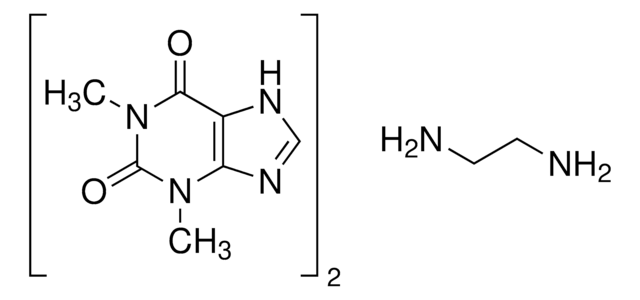This product should be stored in ambient temperature.
Kluczowe dokumenty
T1633
Theophylline
≥99% (HPLC), powder, phosphodiesterase inhibitor
Synonim(y):
1,3-Dimethylxanthine, 2,6-Dihydroxy-1,3-dimethylpurine, 3,7-Dihydro-1,3-dimethyl-1H-purine-2,6-dione
Wybierz wielkość
187,00 zł
Wybierz wielkość
About This Item
187,00 zł
Polecane produkty
Nazwa produktu
Theophylline, anhydrous, ≥99%, powder
klasa czystości
anhydrous
Poziom jakości
Próba
≥99%
Formularz
powder
kolor
white
rozpuszczalność
H2O: slightly soluble 8.3 mg/ml
NH4OH: 50 mg/ml, clear, colorless
alcohol: 12.5 mg/ml
chloroform: soluble 9.1 mg/ml
0.1 M HCl: soluble
0.1 M NaOH: soluble
ammonium hydroxide: soluble
aqueous base: soluble
diethyl ether: slightly soluble
dilute HCl: soluble
dilute nitric acid: soluble
ethanol: moderately soluble
inicjator
Forest Labs
ciąg SMILES
CN1C(=O)N(C)c2[nH]cnc2C1=O
InChI
1S/C7H8N4O2/c1-10-5-4(8-3-9-5)6(12)11(2)7(10)13/h3H,1-2H3,(H,8,9)
Klucz InChI
ZFXYFBGIUFBOJW-UHFFFAOYSA-N
informacje o genach
human ... ADORA1(134) , ADORA2A(135) , ADORA2B(136) , ADORA3(140) , PDE3A(5139) , PDE3B(5140) , PDE4A(5141) , PDE4B(5142) , PDE4C(5143) , PDE4D(5144)
mouse ... Adora2b(11541)
rat ... Adora1(29290) , Adora2a(25369) , Adora2b(29316) , Pde1b(29691) , Pde3a(50678)
Szukasz podobnych produktów? Odwiedź Przewodnik dotyczący porównywania produktów
Zastosowanie
Działania biochem./fizjol.
Cechy i korzyści
Uwaga dotycząca przygotowania
The solubility of the methylxanthines is low, but can be enhanced by the formation of complexes (usually 1:1) with a wide variety of compounds such as ethylenediamine (to form aminophylline). The formation of complex double salts (caffeine and sodium benzoate) or true salts (like choline theophyllinate, and oxtriphylline) also improves aqueous solubility. These salts or complexes dissociate to yield the parent methylxanthines when dissolved in biological fluids and should not be confused with covalently modified derivatives such asdyphylline (1,3-dimethyl-7-(2,3-dihydroxypropyl)-xanthine).
Hasło ostrzegawcze
Danger
Zwroty wskazujące rodzaj zagrożenia
Zwroty wskazujące środki ostrożności
Klasyfikacja zagrożeń
Acute Tox. 3 Oral - Repr. 1B
Kod klasy składowania
6.1C - Combustible acute toxic Cat.3 / toxic compounds or compounds which causing chronic effects
Klasa zagrożenia wodnego (WGK)
WGK 1
Temperatura zapłonu (°F)
Not applicable
Temperatura zapłonu (°C)
Not applicable
Środki ochrony indywidualnej
dust mask type N95 (US), Eyeshields, Faceshields, Gloves
Wybierz jedną z najnowszych wersji:
Masz już ten produkt?
Dokumenty związane z niedawno zakupionymi produktami zostały zamieszczone w Bibliotece dokumentów.
Produkty
Cyclic nucleotides like cAMP modulate cell function via PKA activation and ion channels.
Discover Bioactive Small Molecules for ADME/Tox
-
Buenos días, ¿Cuáles son las condiciones de conservación de la Teofilina? (T1633). Muchas gracias
1 answer-
Helpful?
-
Active Filters
Nasz zespół naukowców ma doświadczenie we wszystkich obszarach badań, w tym w naukach przyrodniczych, materiałoznawstwie, syntezie chemicznej, chromatografii, analityce i wielu innych dziedzinach.
Skontaktuj się z zespołem ds. pomocy technicznej






